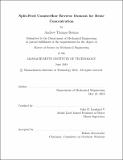Split-feed counterflow reverse osmosis for brine concentration
Author(s)
Bouma, Andrew Thomas
DownloadFull printable version (751.3Kb)
Other Contributors
Massachusetts Institute of Technology. Department of Mechanical Engineering.
Advisor
John H. Lienhard V.
Terms of use
Metadata
Show full item recordAbstract
Brine concentration is a useful operation that allows for increased recovery ratios in water treatment systems, reduction of waste volumes, and the production of minerals from saline brines. As our world moves towards a more sustainable future, improvements in energy-efficient brine concentration will be important. While viable brine concentration technologies exist, current methods are often inefficient. In this thesis, a model is developed to simulate Counterflow Reverse Osmosis (CFRO), a membrane-based, pressure-driven brine concentration technology. Using this model, a single CFRO module is simulated and its performance characterized. Entropy generation within a single-stage system is analyzed, which provides insights for configuring and optimizing multistaged systems. Additionally, a parametric analysis of membrane parameters provides direction for the development of CFRO-specific membranes. Two existing configurations of CFRO are discussed, and compared with a new third configuration, split feed CFRO, which is presented for the first time here. Split feed CFRO systems are simulated and optimized to provide guidance for system design. A variety of multistage systems operating at a range of recovery ratios are simulated, and the results compared are with existing desalination and brine concentration technologies. Potential is shown for the maximum recovery ratio of RO systems to increase significantly when hybridized with split-feed CFRO brine concentration systems, while the energy requirements of these hybridized systems is similar to, or an improvement on, the expected performance of conventional RO systems operating at high pressures and the same conditions. A large reduction in energy usage when compared to commonly used evaporative brine concentrators is shown to be possible.
Description
Thesis: S.M., Massachusetts Institute of Technology, Department of Mechanical Engineering, 2018. This electronic version was submitted by the student author. The certified thesis is available in the Institute Archives and Special Collections. Cataloged from student-submitted PDF version of thesis. Includes bibliographical references (pages 73-77).
Date issued
2018Department
Massachusetts Institute of Technology. Department of Mechanical EngineeringPublisher
Massachusetts Institute of Technology
Keywords
Mechanical Engineering.